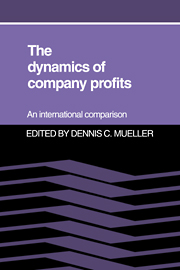Book contents
- Frontmatter
- Contents
- Preface
- Contributors
- 1 Profits and the process of competition
- 2 Modeling persistent profitability
- 3 The persistence of profits in the United States
- 4 The persistence of profits in U.S. manufacturing industries
- 5 The persistence of profitability in Canada
- 6 The persistence of corporate profits in the Federal Republic of Germany
- 7 The persistence of profits in France
- 8 The persistence of profits in Japan
- 9 The persistence of profits in the United Kingdom
- 10 The persistence of profits: international comparison
- 11 The persistence of profits in perspective
- References
- Index
10 - The persistence of profits: international comparison
Published online by Cambridge University Press: 03 May 2010
- Frontmatter
- Contents
- Preface
- Contributors
- 1 Profits and the process of competition
- 2 Modeling persistent profitability
- 3 The persistence of profits in the United States
- 4 The persistence of profits in U.S. manufacturing industries
- 5 The persistence of profitability in Canada
- 6 The persistence of corporate profits in the Federal Republic of Germany
- 7 The persistence of profits in France
- 8 The persistence of profits in Japan
- 9 The persistence of profits in the United Kingdom
- 10 The persistence of profits: international comparison
- 11 The persistence of profits in perspective
- References
- Index
Summary
Proportion of surviving and acquired companies
Table 10.1 presents the number and proportion of companies that survived, were acquired, or were liquidated over the observation period in Canada, France, Japan, the United Kingdom and the United States. The samples are those used in the country studies of persistent profitability in this volume. Unfortunately, at present, comparable figures are not available for other countries.
Out of the 458 Japanese manufacturing companies that were listed in the First Section of the Tokyo Stock Exchange in 1964, 399 firms were still listed in at least one of the eight stock exchanges in Japan in 1984. Thus, over the 1964–84 period, 41 Japanese firms disappeared through mergers and 8 firms went into bankruptcy. Ten firms were not listed in any of the stock exchanges in 1984 for other reasons. The proportion of the companies in the sample that survived over the period is thus 87 percent, whereas the proportion of those companies that were acquired is 9 percent. The inclusion of the companies listed in the Second Section of the Tokyo Stock Exchange in 1964 to the sample makes little difference in the proportions of surviving and acquired firms (column 3).
This finding for Japan makes a clear contrast to the situation in the United States and the United Kingdom. In the United States, of the original 1, 000 companies in 1950, 583 firms still existed in 1972. Thus, over the 1950-72 period, 58 percent of the original firms survived. On the other hand, 384 firms, or 38 percent, of the original 1, 000 firms were acquired over the period.
- Type
- Chapter
- Information
- The Dynamics of Company Profits , pp. 169 - 186Publisher: Cambridge University PressPrint publication year: 1990
- 15
- Cited by



